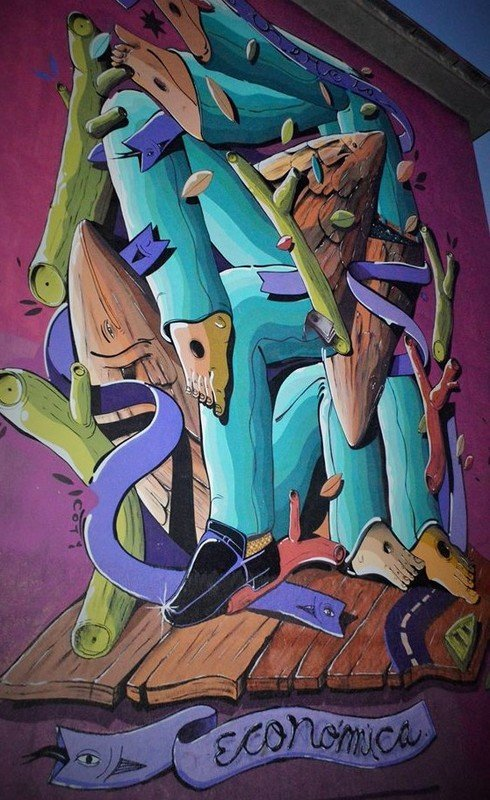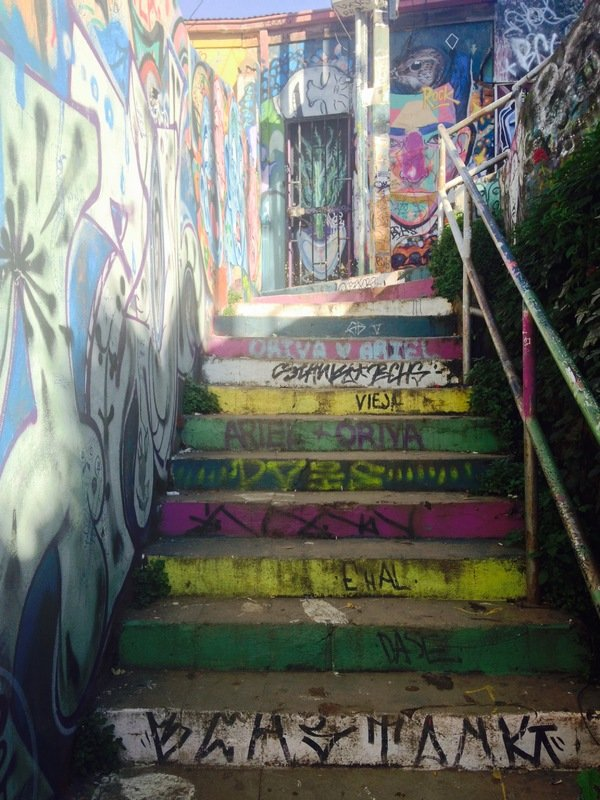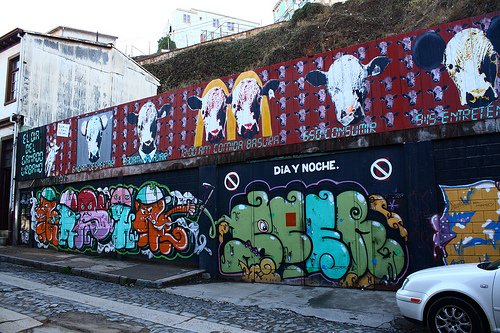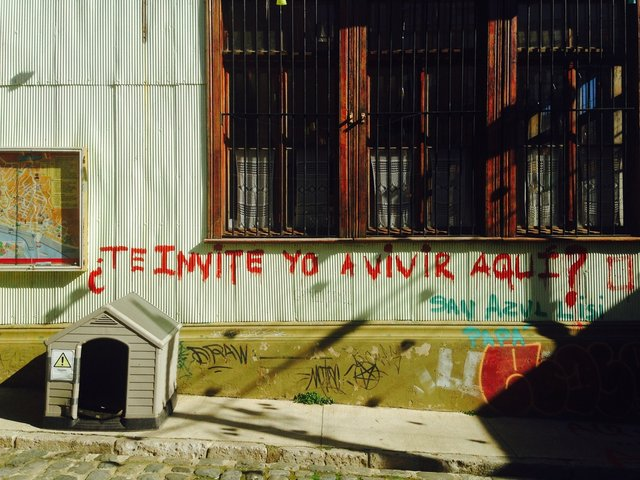How People Have Decentralized Their Own Streets in Chile through Graffiti
Imagine a city where graffiti wasn't illegal, a city where everybody could draw whatever they liked. Where every street was awash with a million colours and little phrases. Where standing at a bus stop was never boring. A city that felt like a party where everyone was invited, not just the estate agents and barons of big business. Imagine a city like that and stop leaning against the wall - it's wet. -Bansky
This is one of my favorite quotes from Bansky, as it shows the very political nature of graffiti and of visibility in public spaces. My first trip to Valparaiso, Chile was in 2014 when I was backpacking around South America. I loved Valparaiso so much for its vibrant life. I believe it is the graffiti capital of the world. Every single corner, street, door, and wall is painted a vibrant color with a unique art piece. The city has an anarchist feel to it, with everyone taking back their individuality and right to be alive the way they want to be alive. This is mirrored in the street art. I have selected a few interesting pieces from Valparaiso and written an analysis of each one.

Chiloe In Valparaiso En Colores
When studying the history of graffiti, the roots can be traced back to poor urban neighborhoods. Specifically, “Fraught conditions of urban communities gave rise to graffiti, where the majority of artists were youth that were “victims of urban renewal schemes and highway building that took place in the middle of the last century” (Lewisohn 7)” (Gleaton 2012: 9). The graffiti movement was a way for these disenfranchised youth to reassert their own rights in public spaces and in their homes. However, when walking around Valparaiso, it is apparent that most of the graffiti pieces are in well-known cerros alegre and concepcion. These cerros are the most wealthy and safe of the city, yet they host the most street art on their walls. This is contrary to the historical rise of graffiti that was originally a response of the poor against the government and big businesses who were controlling their lives. This piece can be found in cerro lecheros, one of the poorer cerros in Valparaiso. It was created as part of a project called “Valparaiso en Colores”, which is aimed at bringing the artform back into the poorer cerros in order to create a safer and more community-based environment.
The project “ Valparaiso en Colores” has commissioned multiple graffiti murals by well-known artists. This artwork in particular was made by an artist originally from Chiloe. Similar pieces showcasing fish with holes in their feet can be found around the city. This piece, along with his others, is a political message about the fishermens’ situation in Chiloe. Gleaton argues that graffiti “remains a vital instrument of protest to bring about social change for communities of people who have no voice. While street art has become mainstream and commercialized in certain instances, the art form offers a visual expression of protest that empowers those who cannot be silenced any longer, and however brief—the shift of power is too great to be ignored.” (Gleaton 2012: 4). In this case, the artist is using graffiti as a means to draw attention to the social and political situation in Chiloe. It shows the fishermen being exploited and squished by business men and economic incentives. This artwork too is a form of protest that lasts for as long as the mural stays on the wall. It is a subtle message, and its politics can be found behind the beautiful exterior. This artist has given a voice to the fishermen in Chiloe who may not have many outlets to voice their situation.

Vandalism Versus Street Art
Graffiti in its very nature is illegal. When graffiti first came into the public eye it was seen as vandalism, whereas today many graffiti pieces are seen as artwork. This shows the shift of graffiti from tagging and throw-ups to murals and street art. However, there exists a fine line between vandalism and art and how to define the two. Gleaton argues that: “To address this question, it is important to first define vandalism as any action involving deliberate damage or destruction to public or private property. This would imply that any and all forms of unsanctioned art occurring in a public space are, by definition, considered illegal vandalism. Because the very definition of vandalism implies the damage and destruction of property, I would argue that not all forms of street art are vandalism, but only those lacking the intention to stand as a meaningful form of expression. Many works occurring in public space are done so with the intention to aesthetically enhance their surroundings and to present a message to the passerby” (Gleaton 2012: 43). I disagree with Gleaton’s claim that one can define the difference between vandalism and street art as whether or not it had the intention to beautify the surroundings and present a message. This definition is subjective and requires a value-based judgement as to what is beautiful and what messages are valid and worth examining.
Furthermore, this definition does not take into account the intrinsic beauty and message behind the very act of tagging. Irvine argues that the importance of graffiti lies in the actual action of tagging a wall rather than what is tagged: “The energy and conceptual force of the work often relies on the act of “getting up”-- the work as performance, an event, undertaken with a gamble and a risk, taking on the uncertain safety of neighborhoods, the conditions of buildings, and the policing of property. As ephemeral and contingent performance, the action is the message” (Irvine: 5). Therefore, behind a name of a crew or a squiggle of lines that may be considered pointless vandalism, there is an artistic intention of resistance and risk. In that message of the action lies the beauty of graffiti.

El Dia Del Ganado Urbano
This piece is titled “El Dia Del Ganado Urbano”, which translates to “the day of the urban livestock”. It shows the typical day of a person living in an urban city. It says: 6:40 wake up, 8:30 work, 12:00 eat garbage, 6:50 consume, 9:15 entertainment. This piece acts as a social commentary to the urban life, and suggests that urban dwelers are all just livestock working for the system. Gleaton writes that: “Through visual imagery and iconography, street art communicates messages that focus on themes such as anti-war, anti-capitalism, anarchism, hypocrisy, greed, poverty, and despair” (Gleaton 2012: 39). This piece is extremely anti-capitalism and provides an alternative discourse on our lives. It is a non-conventional message that uses a non-conventional medium to express itself.
Chaffee writes, “Like the press, one role of street art is to form social consciousness. In authoritarian systems where outlets for free expression are limited, it is one of the few gauges of political sentiment. In more open systems, street art enables various entities to lobby for their interests. Street art, in essence, connotes a decentralized form in which there is universal access, and the real control over messages comes from the social producers (4)” (Gleaton 2012: 17). The piece seeks to shape social consciousness and act as a wake up call to those perhaps walking home from work between their 12:00 lunch of garbage and 6:50 consuming of more garbage. It also disrupts the everyday lives and social truths that we often fail to question.

Te Invite Yo a Vivir Aqui?
After the fire in Valparaiso in 2014, the poorest cerros were in grave conditions. Many families lost their homes and did not have access to basic resources such as clean water. When the mayor arrived to see the damage one man listed out the problems the communities were facing. The mayor’s response to the man was the phrase “Te invite yo a vivir aqui?” which translates to “Did I invite you to live here?”. This response was caught on tape and has been spread around the city, and one artist decided to spread the message through graffiti. Jacques Rancière said that, “Politics is first of all a way of framing, among sensory data, a specific sphere of experience. It is a partition of the sensible, of the visible and the sayable, which allows (or does not allow) some specific data to appear; which allows or does not allow some specific subjects to designate them and speak about them” (Irvine: 20). The communities in the poorest cerros in Valparaiso have very little voice. They are marginalized and their poverty is often depoliticized by those in power. The mayor, in his response, indicated that they do not have a right to either complain about their situation or even live where they are. The people of Valparaiso have used graffiti as a means to empower the voices of these communities and shift the politics of who is allowed to what discourse.
Gleaton writes that: “Graffiti art, as urban youth’s creative response to harsh urban conditions, led to the creation of a new community—one that wouldn’t be destroyed, but instead, was “autonomous and impossible to control” (7)” (Gleaton 2012: 10). Valparaiso is a city with a huge wealth inequality. It is experiencing gentrification and the marginalization of the poor. These poor communities are not only being pushed higher up into the hills with less resources, but they are also being silenced. In response, many have taken to graffiti to resist the affects of urban poverty planning. This graffiti piece is an example of such resistance.
All photos Are Mine.
View this post on TravelFeed for the best experience.